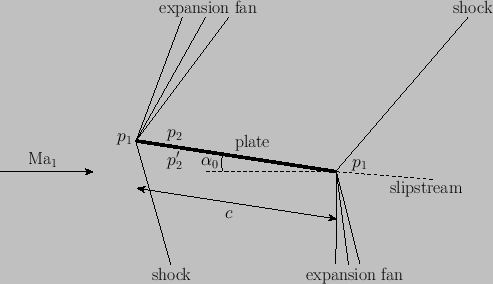 |
 |
Figure 15.10 shows a flat plate inclined at an angle of attack, ![]() , to the oncoming supersonic flow. The streamline ahead of the leading edge is non-inclined, because
there is no upstream influence. Moreover, the flow streams over the upper and lower surfaces are completely independent of one another. Thus, the
flow on the upper surface is turned through an expansion angle
, to the oncoming supersonic flow. The streamline ahead of the leading edge is non-inclined, because
there is no upstream influence. Moreover, the flow streams over the upper and lower surfaces are completely independent of one another. Thus, the
flow on the upper surface is turned through an expansion angle ![]() by means of a Prandtl-Mayer expansion fan
attached to the leading edge of the airfoil, whereas the flow on the lower side is turned through a compression angle
by means of a Prandtl-Mayer expansion fan
attached to the leading edge of the airfoil, whereas the flow on the lower side is turned through a compression angle ![]() by
means of an oblique shock. The flow on the upper surface is recompressed to the upstream pressure
by
means of an oblique shock. The flow on the upper surface is recompressed to the upstream pressure ![]() by means of an oblique
shock wave attached to the trailing edge of the airfoil. Likewise, the flow on the lower surface is re-expanded to the upstream pressure
by means of an expansion fan.
The uniform pressures,
by means of an oblique
shock wave attached to the trailing edge of the airfoil. Likewise, the flow on the lower surface is re-expanded to the upstream pressure
by means of an expansion fan.
The uniform pressures, ![]() and
and ![]() , respectively, on the upper and lower surfaces of the airfoil can easily be calculated by means of oblique shock theory and Prandtl-Mayer expansion theory. Given the pressures, the
lift and drag per unit transverse length of the airfoil are simply
, respectively, on the upper and lower surfaces of the airfoil can easily be calculated by means of oblique shock theory and Prandtl-Mayer expansion theory. Given the pressures, the
lift and drag per unit transverse length of the airfoil are simply
| (15.44) | ||
| (15.45) |
Note that the drag that develops on the airfoil is of a completely different nature to the previously discussed (see Chapter 9) drags that develop on subsonic airfoils, such as friction drag, form drag, and induced drag. This new type of drag is termed supersonic wave drag, and exists even in an idealized, inviscid fluid. It is ultimately due to the trailing shock waves attached to the airfoil.
Comparatively far from the airfoil, the attached shock waves and expansion fans intersect one another. The expansion fans then attenuate the oblique shocks, making them weak and curved. At very large distances, the shock waves asymptote to free-stream Mach lines. However, this phenomenon does not affect the previous calculation of the lift and drag on a flat-plate airfoil.